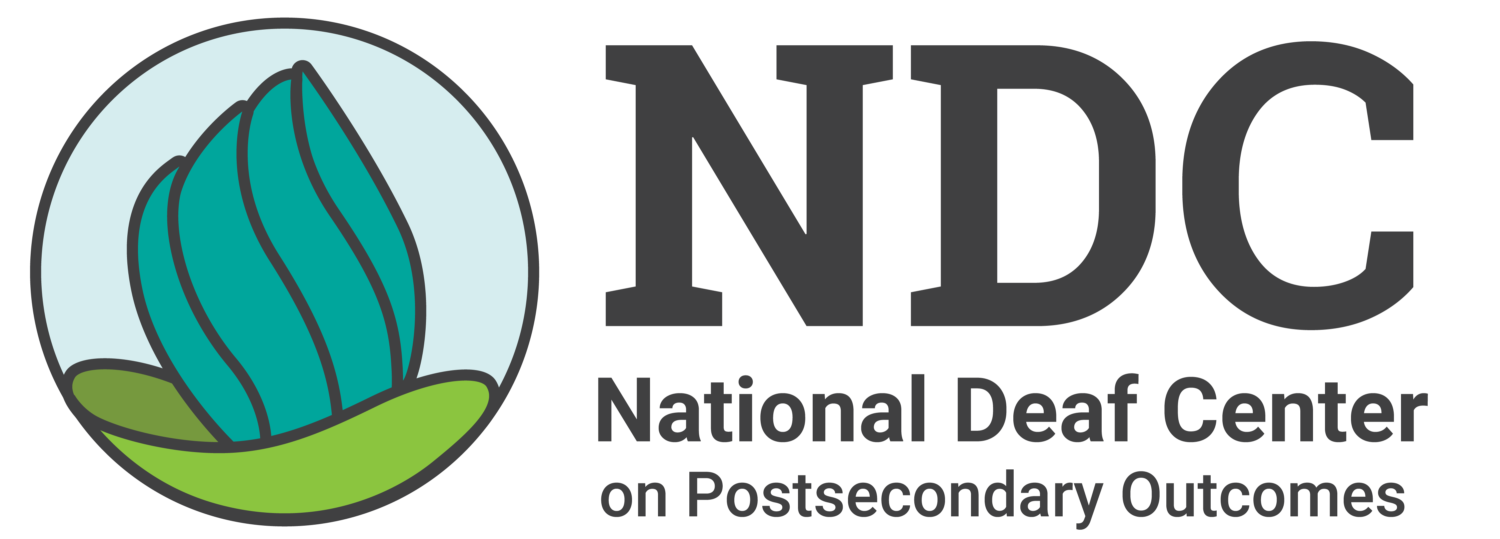Home » Resources » Research & Data » Deaf People and Vocational Rehabilitation: Who Is Being Served?
Deaf People and Vocational Rehabilitation: Who Is Being Served?
Authors: Jeffrey Levi Palmer, Carrie Lou Bloom, Savio Woon-Hay Chan, Stephanie Cawthon, and Adam Sales
Vocational rehabilitation (VR) services are designed to support disabled people in their pursuit of employment goals. VR provides vocational assessment and evaluation, transition skills development, on-the-job training, career counseling, and postsecondary education and training to reduce labor force disparities. In 2017, VR agencies across the nation received 569,530 new applications and served 975,359 people, leading to 175,458 improved employment outcomes (Rehabilitation Services Administration, 2020). Of those people who applied for VR or received services in 2017, 7.9% were deaf.
This research brief provides insight into the characteristics of deaf people who have applied for or received services from VR agencies. The data can be used to inform recruitment efforts, identify gaps in populations being served, and better understand who is being served in the United States. Historically, vocational rehabilitation has sought ways to better serve deaf people by providing staff who are uniquely trained and qualified (e.g., rehabilitation counselors for the deaf, 34 CFR § 361.18) and building relationships with organizations and educational programs that specifically serve deaf people. Despite these efforts, deaf people continue to face significant barriers that contribute to education and employment gaps between deaf and hearing people (NDC, 2019).
Key Findings
Of all the people who applied for or received VR services in 2017, 7.9% were deaf.
A smaller percentage of deaf people who applied for or received VR services were younger than 24 years old (28.2%) compared to other disability groups, in which the average percentage of people under 24 was 48.3%.
On average, a greater percentage of men applied for or received VR services, but among deaf people, a majority were women (51.7%).
White people are overrepresented among deaf people who applied for or received VR services. Only 36.3% of deaf people in the VR database are Black, Indigenous, and People of Color (BIPOC).
A greater percentage of deaf people who applied for or received VR services have been placed on a waiting list (9.2%) than average (6.9%).
A smaller percentage of deaf people who applied for or received VR services (4.4%) received pre-employment transition services (Pre-ETS), or specialized career training for youth, than the average (10.5%).
Disability
In the United States, 13% of people have a disability (U.S. Census Bureau, 2020). Among this population, 51.8% have a mobility disability, 40.1% have difficulty with independent living, 39.2% have a cognitive disability, 28.1% are deaf, 21.5% have difficulty with self-care, and 18.8% have a visual disability. Among deaf people, 20.9% are deafblind, 33.3% are deafdisabled, and 45.5% have no additional disabilities.
Over 94,000 deaf people contacted VR about services between 2017 and 2018, accounting for 7.9% of all the VR case files (Figure 1). Among deaf people, 5% were deafblind, 31% deafdisabled, and 64% had no additional disabilities (Figure 2). The representation of disability groups was different in the VR dataset, where most people had a cognitive disability, and the majority of deaf people did not have additional disabilities. Considering that around 55% of deaf people have additional disabilities according to the U.S. Census, it appears that many deafblind and deafdisabled people are not receiving support from VR or their additional disabilities were not identified within the VR system.
Figure 1: Percentage by Disability
Figure 2: Percentage of Deaf by Disability
Age
Vocational rehabilitation agencies work with a wide range of people, from young adults to older workers who have lost or are in danger of losing their jobs. In 2014, the Workforce Innovation and Opportunity Act (WIOA) was passed to support career advancement, job retention, and increased programming and opportunities for transition-aged youth. As a result, VR agencies started providing more services to younger people. Among deaf people who applied for or received VR services, only 28.2% were younger than 24 years old (Table 1). For other groups, such as people with cognitive and communicative disabilities, the majority of participants are transition-aged youth (58.0% & 76.2%, respectively).
The majority of deaf people in the VR database are between the ages 25 and 64, suggesting that the type of services deaf people need from VR may differ from those that other disability groups need, and the services continue to be needed throughout the course of a deaf person’s life. It is also possible that deaf youth may not be familiar with VR services. A slightly higher percentage of deafdisabled people in the VR database are transition-age youth, compared to deaf people without additional disabilities (34.1% vs. 25.2%; Table 2).
Table 1: Percentage by Age
< 25 | 25-64 | 65+ | |
|---|---|---|---|
All Disabilities | 48.3 | 49.8 | 1.9 |
Cognitive | 58.0 | 41.5 | 0.5 |
Communicative | 76.2 | 23.0 | 0.9 |
Deaf | 28.2 | 61.1 | 10.7 |
Mobility | 24.2 | 72.8 | 3.0 |
Visual | 33.6 | 62.2 | 4.2 |
Table 2: Percentage of Deaf by Age
19-24 | 25-64 | 65+ | |
|---|---|---|---|
DeafBlind | 29.7 | 62.8 | 7.4 |
DeafDisabled | 34.1 | 59.1 | 6.8 |
No Additional Disabilities | 25.2 | 62.0 | 12.8 |
Gender
Although the Rehabilitation Act (P.L. 99-506) is explicit about nondiscrimation, historically, VR has provided services to more men than women (Menz et al., 1989) (Stace, 1987). That trend continues to be true today, where the majority of people who applied for or received VR services were men (55.6%). However, among deaf people, a slight majority are women (51.7%).
Race & Ethnicity
In the United States, 28.3% of disabled people are Black, Indigenous, and People of Color (BIPOC) (U.S. Census Bureau, 2020). Across race and ethnicity groups, the group of deaf people least represented compared with other disability groups are Black deaf people, who were only 14.8% of deaf people compared to 23.2% of hearing people in the VR database. There is little difference in the percentage of BIPOC across deafblind, deafdisabled, and deaf people without any additional disabilities.
Waiting List
When there are not enough resources to serve everyone who has requested services from VR, agencies are expected to prioritize services for people with the most significant disabilities and those who are in danger of losing their jobs, a process that is called order of selection (OOS). Many states have implemented OOS through the use of waiting lists. In this dataset, 6.9% of all people who applied for or received VR services have been on a waiting list. A higher percentage of deaf people (9.2%) or nearly 9,000 deaf people, are currently on or have been placed on a waiting list.
Even though OOS is designed to prioritize people with significant disabilities, 8.6% of deafdisabled people and 5.2% of deafblind people have been on a waiting list. Due to variable resources across states, the percentage of deaf people being placed on waiting lists may be much higher in some states than in others.
Social Security Benefits
In the United States, 12.3% of deaf people between the ages 21 and 64 received Social Security Income (SSI) in 2018, and 4.7% of people between the ages 18 and 64 received Social Security Disability Insurance (SSDI). For the most part, people who receive disability benefits are presumed to be eligible for vocational rehabilitation services.
In this dataset, 19% of VR participants receive SSI and 15% receive SSDI. The percentage of participants receiving SSI and SSDI in the VR case files varies across disability groups. For example, approximately 24% of people with a mobility or visual disability receive SSDI compared to 14% of deaf people. A larger percentage of deafblind and deafdisabled people receive financial assistance from the Social Security Administration than deaf people without additional disabilities.
Pre-Employment Transition Services
In 2014, the WIOA required VR agencies to dedicate 15% of their federal funds for pre-employment transition services (Pre-ETS) to disabled youth who are currently enrolled in school (20 CFR § 683.120). Pre-ETS are designed to support transition-aged students with career exploration and preparation for adult life. In 2017, more than 4,000 deaf people received Pre-ETS through VR. Overall, only 4.4% of deaf people who applied for or received VR services received Pre-ETS (Figure 8). Nearly 27,000 deaf people in the VR database are under 25 years old (see Table 1) and many of them qualified for Pre-ETS, but did not receive it. Among deaf, more deafblind (5.8%) and deafdisabled youth (6.7%) received Pre-ETS than deaf youth without any additional disabilities (3.3%). The data from 2017 reflect early stages of Pre-ETS implementation; current data would be expected to show higher rates of service provision.
Figure 8: Receiving Pre-Employment Transition Services
Conclusion
Vocational rehabilitation is an important source of support for deaf people who are working toward their employment goals. In 2017, 94,517 deaf people applied for or received VR services. Key takeaways from this data report are summarized below, along with specific considerations for VR agencies.
- The majority of deaf people in the VR database were white. VR agencies may need to strengthen relationships with deaf BIPOC communities and recruit more deaf BIPOC VR counselors and service providers.
- A larger percentage of deaf people have been placed on waiting lists than other disability groups. VR agencies may need to evaluate policies and procedures related to placing deaf people on waiting lists and ensure the availability of appropriate assessment and identification of additional disabilities.
- A smaller percentage of deaf people received Pre-ETS than other disability groups, and fewer deaf people under the age of 25 applied for or received VR services. VR agencies may need to increase their capacity to reach out to deaf youth and provide Pre-ETS.
For more information and additional charts and graphs, please view the full report below
References
Rehabilitation Services Administration. (2020). The state vocational rehabilitation services program before and after enactment of The Workforce Innovation and Opportunity Act in 2014.
National Deaf Center on Postsecondary Outcomes. (2019). Research summarized! Key impact areas.
U.S. Census Bureau. (2020). 2018 American Community Survey, 1-year Public Use Microdata Sample [Data Set]. https://www.census.gov/programs-surveys/acs/data/pums.html
Menz, F., Hansen, G., Smith, H., Brown, C., Ford, M., & McCrowey, G. (1989). Gender equity in access, services and benefits from vocational rehabilitation. Journal of Rehabilitation, 55(1).
Stace, S. (1987). Vocational rehabilitation for women with disabilities. International Labour Review, 126(3), 301–316.
Garberoglio, C. L., Stapleton, L. D., Palmer, J. L., Simms, L. E., Cawthon, S. W., & Sales, A. (2019). Postsecondary achievement of Black deaf people in the United States. The University of Texas at Austin, National Deaf Center on Postsecondary Outcomes.
Cuevas, S. (2018). Factors contributing to successful employment outcomes for individuals who are hard-of-hearing [Doctoral Dissertation]. University of Texas Rio Grande Valley.
Moore, C. (2002). Outcome variables that contribute to group differences between Caucasians, African Americans, and Asian Americans who are deaf. Journal of Applied Rehabilitation Counseling, 33(2), 8–12.
Erickson, W., Lee, C., & von Schrader, S. (2017). Disability statistics from the American Community Survey (ACS). Cornell University, Yang-Tan Institute. www.disabilitystatistics.org
Social Security Administration. (2019). Annual statistical report on the Social Security Disability Insurance Program, 2018. https://www.ssa.gov/policy/docs/statcomps/di_asr/2018/index.html
NDC is a technical assistance and dissemination center supported by a cooperative agreement with the U.S. Department of Education’s Office of Special Education Programs. NDC provides evidence-based strategies to deaf people, family members, and professionals at the local, state, and national levels with the goal of closing education and employment gaps for deaf people. This publication was developed under a jointly funded grant through the Office of Special Education Programs and the Rehabilitation Services Administration, #H326D160001. However, the contents do not necessarily represent the positions or policies of the federal government. Electronic versions of this report and all other NDC data reports are available at nationaldeafcenter.org/research-data.
We would like to thank our NDC colleagues for providing thoughtful feedback and support throughout the report development process, as well as Purvi Sevak and Todd Honeycutt from Mathematica Policy Research for helping us understand the nuances of this dataset. We would also like to thank Bedarius Bell Jr. and the VR task force from the National Association of the Deaf for their input.





